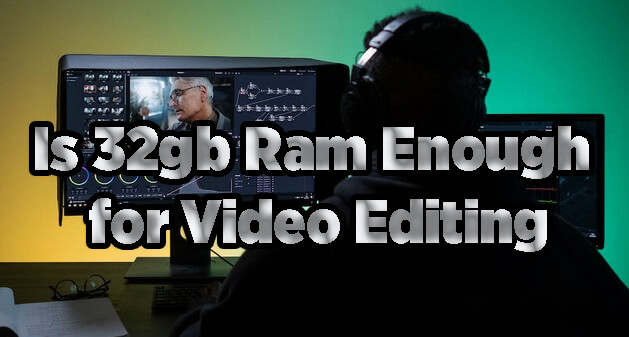Among the critical components, RAM (Random Access Memory) plays a pivotal role in determining how smoothly your editing software operates, especially when dealing with resource-intensive tasks. In this guide, we discuss the question on every video editor’s mind: Is 32GB of RAM enough for video editing?

Understanding the Basics:
Before we dive into the specifics of whether 32GB of RAM suffices for video editing, it’s crucial to comprehend the role RAM plays in this process. RAM serves as temporary storage for your computer’s active tasks, providing quick access to data that your CPU & software need in real-time. In the context of video editing, a substantial amount of RAM is essential for seamless multitasking, efficient rendering, and smooth playback.
Why 32GB of RAM?
1. Multitasking Demands:
Video editors often choose higher RAM capacities primarily due to the need for multitasking. When engaged in a project, it’s common to run multiple applications randomly, including video editing software, graphic design tools, audio editing programs, and more. A 32GB RAM configuration allows for the seamless handling of these tasks, ensuring a workflow that is both smooth and uninterrupted.
2. Video Resolution and Complexity:
The resolution and complexity of your video projects significantly impact the RAM requirements. 4K and higher resolution videos, coupled with intricate visual effects and layers, demand a substantial amount of memory. 32GB can accommodate the data load associated with high-resolution projects, preventing slowdowns and enhancing overall editing efficiency.
3. Rendering Speed:
Video rendering, the process of generating the final output, is a resource-intensive task. A higher RAM capacity allows your computer to store more data for rendering, resulting in faster export times. This is particularly advantageous for professionals or content creators on tight deadlines, where every minute counts.
When 32GB Might Fall Short:
While 32GB of RAM is ample for many video editing scenarios, certain situations may warrant higher capacities.
1. 8K Video Editing:
As the industry moves towards higher resolutions, such as 8K, the demands on system resources escalate. Editing 8K footage with multiple layers and effects could strain a 32GB RAM setup. If you find yourself consistently working with such high-resolution content, opting for 64GB or more might be a wise investment.
2. Complex 3D Animations:
Video editors venturing into the realm of 3D animations and modeling might encounter limitations with 32GB of RAM. These tasks, often associated with advanced video production, can be memory-intensive, requiring more space to store and process the intricate details.
3. Virtual Machines and Workloads:
For those engaged in complex workflows involving virtual machines, running multiple instances of resource-hungry applications simultaneously, or handling massive datasets, a 32GB RAM configuration may struggle to keep up. In such scenarios, a higher RAM capacity becomes essential for optimal performance.
Optimizing Your Video Editing Experience:
While the debate over whether 32GB of RAM is enough for video editing continues, there are strategies to optimize your editing experience with this capacity.
1. Efficient Resource Management:
Close unnecessary background applications and allocate resources judiciously. Many video editing software allow you to adjust settings to optimize performance based on available RAM.
2. Utilize Proxy Editing:
When working with high-resolution footage, consider using proxy editing. This involves creating lower-resolution versions of your files for editing, reducing the strain on your system resources. The final export, however, is in the original high resolution.
3. Regular Hardware Upkeep:
Ensure your system is well-maintained. Regularly update drivers, clean up storage space & consider investing in a fast SSD (Solid State Drive) for your operating system. Frequently used applications to enhance overall system performance.
How much RAM for video editing 4k?
For optimal 4K video editing performance, it is advisable to have a minimum of 32GB of RAM, ensuring a seamless and responsive editing experience. This amount of memory facilitates improved multitasking, effective management of large video files, and smoother playback throughout the editing process. The ideal RAM capacity, however, may vary based on the complexity of your projects and the specific video editing software you utilize.
In some cases, you may find significant advantages in upgrading to 64GB or even more RAM. Sufficient RAM becomes especially crucial when dealing with multiple high-resolution video clips, applying intricate visual effects, and undertaking color grading tasks. Moreover, the synergy of ample RAM with a robust graphics card and a high-speed storage solution, such as an SSD, is essential for creating an optimized 4K video editing setup.
Conclusion:
Assessing factors such as video resolution, complexity, and the nature of your editing tasks will guide you in determining whether 32GB is sufficient or if a higher RAM configuration is warranted. As technology advances and video production standards continue to rise, staying attuned to your system’s capabilities ensures a seamless and efficient video editing experience.
Read also: Is 128gb Ram Overkill [You Should Know]
FAQs –
Q 1. Can I edit 4K videos with 16GB RAM?
Answer: While it’s possible to edit 4K videos with 16GB RAM, a more seamless experience is achieved with 32GB or more. Higher RAM enables better performance, especially in complex editing tasks.
Q 2. Is 32GB or more necessary for 4K and higher?
Answer: Yes, having 32GB or more of RAM is recommended for 4K video editing and higher resolutions. It ensures efficient handling of large files, smooth playback, and improved overall editing experience.
Q 3. What is the maximum RAM for video editing?
Answer: The maximum RAM for video editing depends on the complexity of your projects. While 32GB is a good starting point, some users may benefit from 64GB or more, especially when working on intricate projects with multiple high-resolution clips and effects.
